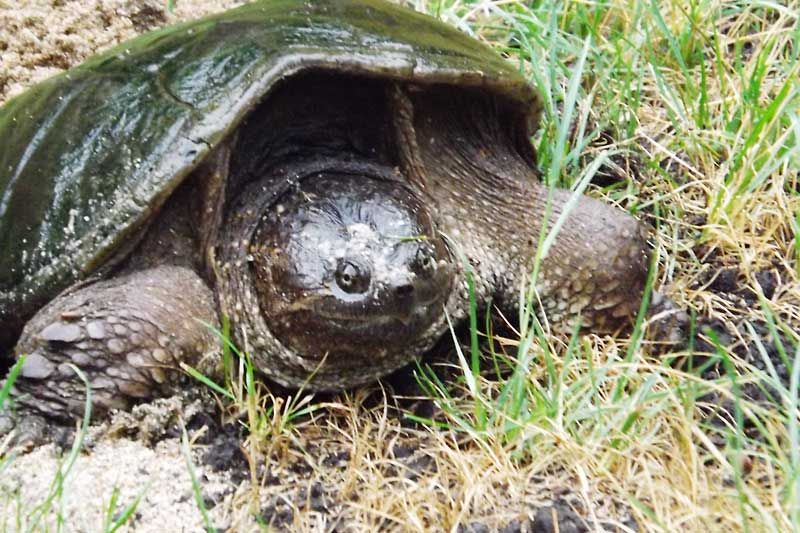Jun 26, 2014
By Lorraine Julien
My neighbours had a visit recently from a large Snapping Turtle. The turtle laid her eggs on a septic bed where the ground was nice and sandy and good for digging. Snappers have very few natural enemies but their eggs seldom hatch before being eaten by raccoons, foxes, skunks and even opossums. Usually 40 to 50 eggs are laid in a sunny location where they hatch in the fall. The incubation temperature determines the gender of the hatchlings. A lot of turtle eggs did not hatch last year probably due to the cool rainy weather.
If it rains shortly after the eggs are laid, or if water is generously sprinkled on the site, the eggs may stand a chance of hatching. Raccoons and other predators can easily smell fresh laid eggs and will destroy the nest and eat all the eggs – water will reduce the enticing odour, though.
Although we have a property nearby, we have seen mostly Painted turtles with only the occasional visit in our bay from a Snapper. Turtles especially love shallow bays with soft sandy or muddy bottoms. They plow along the lake bottom and push mud aside to create little channels that small animals, like frogs, small reptiles, fish and even muskrats will use to go about their daily lives. They’re also like little garbage disposals. They’ll eat dead animals, fish, weeds or almost anything else that is rotting. They clean up the environment because they’re omnivores. Since they clean up all the garbage, they also take in many toxins and, for this reason, they are not safe for human consumption.
The Snapping turtle is Ontario’s most prehistoric looking turtle species. In a safe, natural environment, wild Snappers can live well past 100. In Ontario, females do not begin to breed until they are 17 to 19 years old. Even in Algonquin Park, where turtle hunting is prohibited, the chance of survival from egg to maturity is 0.07 per cent based on research. That means that for every 10,000 eggs laid, only 7 babies survive to adulthood. They’ve been around for about 90 million years so you’d wonder how they have survived. Of course, there weren’t heavily travelled roads for most of those millions of years and, once the Snappers reach maturity, they have very few natural enemies.
There is a real fallacy about Snapping turtles and that is they may bite you when you are swimming. This is not true. Unlike most other Ontario turtles, the Snapping turtle has a very small plastron (hard undershell) and cannot withdraw into its shell for protection when threatened. Therefore, on land this turtle’s only defence from predators is to snap repeatedly and scare them away. In water, the Snapping turtle rarely snaps at people or other potential threats and will simply swim away if threatened. They’re not very good swimmers and prefer instead to walk on the lake bottom. On a sunny day, when the light angle is right, it’s easy to spot them from a kayak or canoe.
The Snapping turtle is currently listed as Special Concern under the Ontario Endangered Species Act, 2007 and Special Concern under the Federal Species at Risk Act. The species has also been designated as a Specially Protected Reptile under the Ontario Fish and Wildlife Conservation Act. There are other acts that are in place to supposedly protect this reptile but, unfortunately, hunting is still allowed in Ontario (2 Snapping turtles per day per person!) Organizations have strongly urged the Ontario government to remove the Snapping turtle from the list of game species in Ontario but so far they’ve been ignored. You can help by signing a petition - one website I encountered is: action.davidsuzuki.org/snappers
In 2012, as reported in the Toronto Star, York Regional police stopped a car travelling the back roads northeast of Toronto. Police suspected they’d uncovered a stash of marijuana as the car was filled with damp tote boxes. What a surprise when the officers heard “ribbit, ribbit” from one box and a turtle poked its head out from another box! Police had unknowingly uncovered a wildlife heist. The poachers had plundered the Lake Scugog area and had 10 live Snapping turtles, 123 bullfrogs and 2 Midland painted turtles – animals likely destined for restaurants or the underground exotic pet industry.
Then there are the road hazards. However, please remember that when driving in traffic it is very dangerous to stop to try to help these creatures. Readers are strongly reminded never to create any kind of a traffic hazard in their efforts to save turtles.
Some conservationists fear these slow-moving, ever-chomping creatures from the dinosaur age may be on a path to extinction. It is the oldest Snapping turtles that are the long-term breeders but, unfortunately, those are the ones that are popular with legal and illegal harvesters because of their large size. If these animals continue to be hunted, the path to extinction will sadly be much quicker.
More Stories
- No Winner Yet in Catch The Ace But Fundraising Target Met
- South Frontenac Food Bank Opens Second Location in Battersea
- Sharbot Lake Pentecostal Church Anniversary - 1925-2025
- Frontenac Holistic Health Fair - September 20 At Storrington Centre
- Odd Year For Real Estate - But Sales Are Steady Year Over Year
- 193rd Kingston Fall Fair
- Kim Phuc - the Napalm Girl - To Visit Flinton In November
- South Frontenac Council - September 2
- Sticker Shock - EV Charging Station To Cost North Frontenac Township
- 30th Anniversary Verona Car Show

